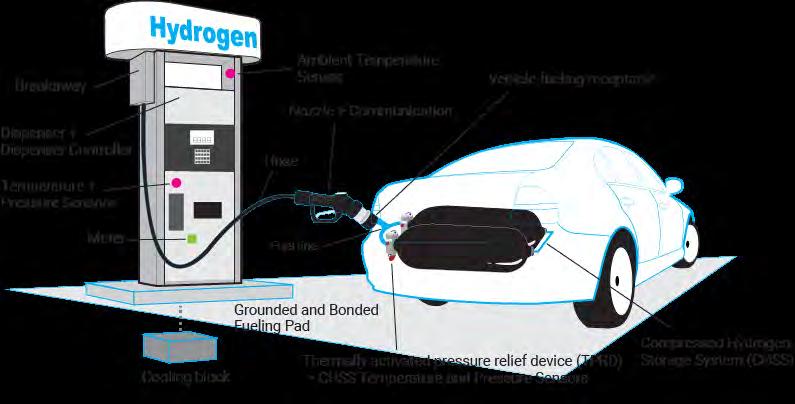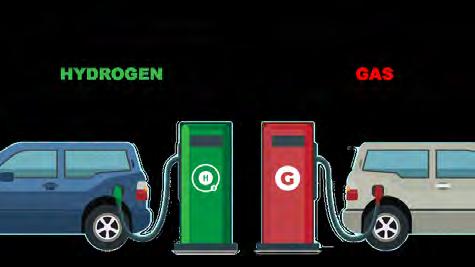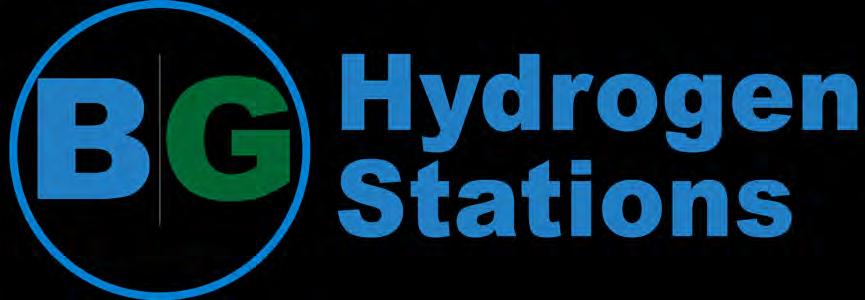

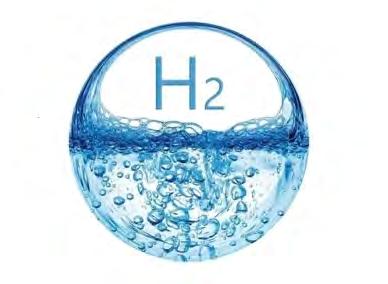

Executive Summary
Blue Green Energy believes that the United States is moving towards and will continue moving towards alternative fuel sources including hydrogen. We believe that in the next ten to twelve years every gas station in the Country will have hydrogen pumps. While we may not see the elimination of petroleum-based fuels in our lifetime that doesn’t mean there isn’t money to be made by investing in the hydrogen infrastructure right now. The transition to zero emission vehicles will take decades but auto and truck manufacturers are already selling hydrogen vehicles. When Saudi Arabia is building 22 new hydrogen plants and has already inked deals to supply entire countries with hydrogen, we believe the writing is on the wall. Blue Green Energy, Inc. has positioned itself as an early adopter in the hydrogen economy, We believe that we have a highly executable business model capable of becoming a billion-dollar energy company.
Despite our love for the internal combustion engine, cars and trucks are moving away from gasoline and diesel. It is only a matter of time before the sale of pure Internal Combustion Engine (ICE) cars are banned. In the U.K. that’s 2030, In California that’s 2035, and it is 2050 on a national level. Hybrid / Electric / and fuel cell are the vehicles of the future. The problem with Electric Vehicles (EV) is that they rely on power from an already overloaded grid. There are additional issues with battery recharge times, the weight of batteries, and the recycling of batteries. At present battery electric is not seen as a viable option for class 8 trucks. With their limited range, long recharging times, and reduced cargo capacity due to the additional battery weight – fuel cells are a better option. The lack of hydrogen fueling stations is what is limiting the adoption of the technology. Toyota and Hyundai sell H2 vehicles primarily in California. In addition to tax credits, Toyota offers a $25,000 rebate and $15,000 in hydrogen. It’s a great deal - just don’t try to drive your hydrogen car to Las Vegas. You’ll make it here, but you won’t make it back.
Blue Green Energy is solving this problem by building a hydrogen refinery and filling station between Los Angeles and Las Vegas. Our facility will be the first in the U.S. to manufacture 100 percent green hydrogen using renewable energy sources. Our facility includes 30-megawatt solar farm spanning 200 acres and over 100,000 panels. We will extract hydrogen from water using electrolysis. While this process requires a significant amount of power, we will have capacity of 8000 kilograms of hydrogen daily generating $46 million per year. We will be a zero-emission facility unlike 95% of the hydrogen in the United States that is made from “dirty” natural gas. Commercial solar installations at scale average $0.80 to $1.01 per watt putting our build cost at $30,000,000.
We have identified three suitable locations between Las Vegas and Los Angeles to build a hydrogen refinery and fueling station - BGE will use its hydrogen fuel cells to generate electricity for rapid DC charging of electric vehicles. Unlike current charging stations that are installed at current gas stations, hotel parking lots, and shopping centers BG fueling, and travel centers will be built specifically to accommodate the time it takes to recharge a vehicle or to fill a truck with hydrogen. All our facilities will offer a comfortable waiting area out of the elements. Most facilities will have a convenience store and certain facilities will incorporate national food and coffee chains.
To execute our business model and to raise the additional funds required to bring our facility online, we are selling up to 3,000,000 shares of Series A Common Stock at a price of $2.50 per share with a $50,000 minimum investment. Our offering is being made in reliance to Rule 506(c) of regulation D and is being made to accredited investors only. Shares are offered on a best-efforts basis, and we reserve the right to reject any subscription from prospective investors for any reason.
We will be conducting a concurrent $5,000,000 crowdfunding offering. Combined we will sell up to 3,000,000 shares of common stock at $2.50 a share for total proceeds of $7,500,000. Funds from this round will be used to acquire property and start the permitting process. After this offering there will be two more rounds of financing between $5.00 and $7.50 a share for a total of an additional $105,000,000. Total capital raised through all rounds is expected to be $113,500,000 with 27,250,000 shares issued and outstanding.
We believe that Blue Green Energy, Inc. will capitalize on what’s Goldman Sachs is calling the next trillion-dollar industry by producing, distributing, and retailing hydrogen.


The Company
MISSION
Fifty Countries and twelve States have already banned the sale of gasoline powered vehicles by 2035. We believe that battery electric is not a viable, scalable solution to achieving net zero and there’s zero possibility of having 100 percent of people driving a BEV. The only way for the world to achieve net zero emissions is through investments in the hydrogen infrastructure. Blue Green Energy is committed to producing zero CO2 emissions through the production of “green” hydrogen. Green hydrogen is made using water and electrolysis. Our mission is to build BG fueling stations across the Country, maximizing returns for our investors, all while doing our part to clean up the environment.
BUSINESS OVERVIEW
The world is transitioning away from fossil fuels. Vehicle manufacturers are committed to producing hydrogen powered cars in the form of both fuel cell electric and internal combustion engines. Honda, Hyundai, and Toyota have been selling fuel cell electric cars running on hydrogen for ten years in California. BMW has three new models of hydrogen powered vehicles and Mercedes has two. In 2026 all EVs coming from General Motors will be fuel cell electric. Cummins has converted their 15-litre diesel to run on hydrogen and Hyzon, Hyundai, Nikola, and Daimler are all selling fuel cell electric class 8 trucks.
Fuel cell electric vehicles do not rely on strip mining for lithium or cobalt, or billions of dollars in government subsidies like battery electric vehicles. More importantly they are not relying on an aging power grid to charge them. This is the glaring problem nobody seems to talk about. States like California want you to buy an EV – just don’t charge it during the day.
Fuel cell electric vehicles are simply better than their battery electric counterpart. What they are not – is convenient. There are only a limited number of hydrogen stations in California and Hawaii. Fuel cell electric vehicles cannot simply plug their cars in like a battery electric vehicle. They must go to a station every 400 miles, which is the average range for passenger vehicles, and fill up with hydrogen. Refueling times are like a gasoline powered car, but again there are not enough stations This is why State and Federal governments are doling out grant money to build the infrastructure. We already know the only way net zero works is with hydrogen, but the only way hydrogen works is with investments in the hydrogen infrastructure. This is where Blue Green Energy Comes in.
We are acquiring property, plant, and equipment. We are building hydrogen production facilities with onsite fueling / travel centers. Our intent is to cover all five shipping routes leaving the ports of Long Beach, CA. Forty percent of all goods coming into the United States arrive in Long Beach. The port of Long Beach has been operating fuel cell electric Mack trucks for ten years and there are plans to move all trucks away from Diesel. In fact, in 2023 CA proposed banning Diesel by 2036 and when they meet with the truck manufactures the truck manufactures put up no fight. Our opinion is that the trucking companies see this as an opportunity to sell new trucks. Additionally, numerous fleet operators are acquiring hydrogen powered trucks, but are being forced to build facilities at their yard to enable local deliveries. Blue Green Energy’s issue with this is that without facilities like ours – along the interstate – long haul trucking is impossible. While we will happily fill hydrogen vehicles at our facility, our emphasis is on the hydrogen trucks. Passenger vehicles hold 5.5 kilograms (KG) of hydrogen, but trucks hold 80 KG. Due to the location of our facility, if we assume we’re filling half a tank on average, the 8000 KG of hydrogen that we produce daily is only enough for 200 trucks at half a tank a day.


If we were only doing passenger vehicles that number would be 3,555. There are simply not enough hydrogen passenger vehicles on the road to make that realistic. Trucks are where the moneys at. Thus, the emphasis, at least initially, on fueling stations.
Our plan is to develop self-contained hydrogen productions facilities that produce hydrogen from water using electrolysis. Our first facility will include 200 acres of solar panels generating 30 megawatts of energy to produce 8000 kilograms of hydrogen daily. As discussed earlier, that is enough hydrogen for 200 trucks at half a tank daily. Hydrogen sales alone are projected to be $46M per annum. Once we factor in all other services like restaurant, convenience store sales, battery electric car and truck charging, overnight truck parking, etc. We are looking at an upside potential of each facility more than $100 million once we factor in both production and investment tax credits. Note that we do not need tax breaks and incentives to have a successful business, but if the money is available, we will take it.
To date, we raised $1.25 million from investors in our seed round at $1.00 per share. We have identified three suitable properties to build our facility. This round of financing is for the purchase of property. This round of financing coincides with a crowdfunding round of $5,000,000 which is at the same $2.50 per share but available to non-accredited investors. We are conducting this round prior to crowdfunding as we wait on necessary approvals. There will be a total of $7,500,000 raised at $2.50 a share for a total of 3,000,000 shares sold. As we acquire assets, and move forward with permitting, zoning, and construction the shares will increase in price.
Due to the size and complexity of this project we have broken the project down into phases. There are three distinct phases to the buildout as well as the expansion, or post IPO phase. We will discuss each in the following section.
Phase
I
Phase one is the acquisition of property, permitting, zoning, and regulatory approval. We have already completed our initial seed round, and this is the phase we are in right now. The main use of capital in this raise, along with our concurrent $5.0M Crowdfunding round, is to acquire property. Once we take possession of the property several things will occur:
- Start the permitting process.
- Install temporary / mobile hydrogen pumps on a temporary pad.
- Apply for California grant money.
- Begin grading, fencing, flood control measures, and general improvements.
- Engage project manager / consultant.
- Solidify bids for all equipment including building contractors and commercial solar installation.
- Hire Domestic architectural firm to finalize building plans and submit for approval.
Phase II
Phase two will begin with the solar installation. We will be installing 30 megawatts of solar covering approximately 200 acres at a cost of $30,000,000. We will be building six 5MW grids that will be tied together. Doing it this way we don’t have to wait until all the capital is raised, we can build out the solar installation as the money comes in reducing the overall time it takes to bring the facility online.
During this phase we will be raising capital through Regulation A+ offerings which are qualified by the SEC and permit non accredited investors. Most of your investments come from your advertising efforts where prospective investors are directed to your website and are tempted by low minimums. Everything is tied into all the payment processors, and you can purchase shares on your credit card. All transactions go through a broker and funds are deposited into our escrow account monthly. We expect to ramp up our efforts and raise approximately $5,000,000 monthly. So while this is a big project, with the funding coming in at that level we will be able to move forward quickly.


In addition to the solar installation, during this phase we will:
- Select building contractor.
- Finalize all equipment selection (EV chargers, Electrolyzers, Storage Tanks, Pumps, Storage systems, etc.).
Phase III
Phase three is where we begin building the 35,000 sq ft fueling station / travel center. The facility will include a national, well-known restaurant, a coffee franchise, and a convenience store. The business model is very similar to Bucees where people traveling the roadways stop even if they don’t need fuel. We are also installing 16 Level III chargers for Rapid DC charging of battery electric vehicles. We are creating a facility where if you have a hydrogen car or truck you need to stop because we are the only facility. If you have a battery electric car, which there are far more of than fuel cell electric, you don’t have to stop at our facility, but you do have to stop in that region. Given the choice between a world class facility with restaurants, coffee shops, and other amenities we’re guessing most people will chose to charge their cars at our facility. The day the facility is open to the public is the day we file for IPO.
Post Grand Opening
Thus far we have discussed opening our first facility and the capital requirements to do so. In this section we will discuss our post IPO growth strategy. Blue Green Energy, Inc. intends of filing for IPO once our first facility is open to the public We anticipate raising enough capital in an underwritten IPO to open four additional facilities covering all shipping routes heading out of the port of Long Beach. This would include I-8, I-10, I-40, I-5, and I-15. Each subsequent facility will be a carbon copy of the first with the same hydrogen production and the same amenities.
We will continue to build these trucks stop / travel centers every 250-300 miles along major shipping routes with the goal of covering the entire United States. Initially we will start west of Colorado, then move east to Texas, and finally move to the east coast.



Mobile Fueling & Charging Units
Once we take possession of the property, we will build a temporary pad and install mobile hydrogen filling units. Going forward we will use these units to expand into new areas while the hydrogen market develops. As of today there are very few manufactures of hydrogen pumps and storage tanks. As such, the equipment is far more expensive than it will be a few years from now. In California, Grant money pays for most of the equipment costs for stations that want to sell hydrogen. However, the average station cost is still $3,500,000. It makes the most sense to install less expensive mobile units while H2 demand increases, and equipment costs decrease.
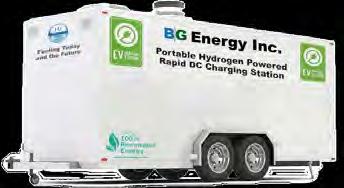

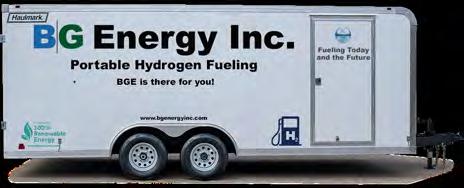
Additionally, our plan includes H2 powered Level III rapid DC chargers. Not only are these chargers’ 100 percent green but they can also be operated in remote areas not tied to the grid. A big advantage to these units, as the world transitions away from fossil fuels is they can be placed on construction sites, taxi yards, and even placed with trucking companies that are currently purchasing hydrogen trucks. Our Fuel Cell (FC) generators will provide Rapid DC Fast Charging for BEVs at our stations. Our DC Fast Charge stations will provide the maximum charge rate of 350-kw DC service at 500amps for your BEV with no compromise on charging speed due to electric grid or companies power issues.
Hydrogen capacities range from 20 kg to over 1,000 kg per day, dispensed at 350 or 700 bar that’s enough hydrogen to power 32 fuel cell buses for 218 miles, or 1,000 fuel cell cars for 62 miles every day! Modular stacks can be scaled for even higher outputs to service the largest demand. And when used with renewables, there’s no carbon footprint.
Charging Times:
Depends on the charging level, the maximum power output of the charging station and max power intake of your EV. There are 3 levels of chargers:
• Level 1 (120 volt) charging – most homes
• Level 2 (240 volt) charging – majority of public charging
• Level 3 (480 volt) Supercharging or DC fast charging very limited
All the above charging stations rely on the public power grid for operation, so these stations are at the mercy of the utility company as far as how much energy/power they can provide at each station.
Our Pure Green Hydrogen Fuel Cell Powered Rapid DC Fast Charging Stations always provide the maximum amount of power as they are self-contained station with a Level 3 output of 350-kw DC service at 500amps, which is more than any public charge station.
Our Charging stations using DC current at high power which allows for fast charging in 30 minutes instead of 6 hours.
*The EV controls the speed of the charging and once charging begins and the battery warms up, EVs typically draw the maximum flow of kilowatts that are available from the charger.



BG Fueling Stations (not truck stops)
Our plan is to expand the hydrogen infrastructure outside of California. On the west coast Oregon, Washington, New Mexico, and Colorado have all followed suit with California in banning gasoline powered car sales by 2035. It won’t be long before Nevada and Utah do the same. Utah is planning to build a green hydrogen power plant, so they are already on the path to net zero. Before long, these states will run out of energy just like California and be forced to invest in the hydrogen infrastructure. Blue Green Energy wants to expand into these states prior to that happening and become the market leader in the hydrogen space.
As discussed previously, hydrogen equipment is expensive. Many companies are not willing to make the financial commitment necessary to install hydrogen pumps. Especially considering that outside of California and Hawaii, no manufactures sell hydrogen vehicles. Blue Green Energy will partner with existing stations to install hydrogen equipment, supply stations with hydrogen, and give these stations a percentage of the revenue. This makes sense for all parties. Companies don’t have to take a big financial risk to take advantage of where the future is headed. Even if manufactures stopped producing gasoline powered cars today, it would still take 25 years to replace all the gasoline powered cars on the road. Partnering with Blue Green Energy during this transition is the best path forward.
In addition to partnering with existing facilities Blue Green is also going to build corporate owned facilities and offer franchised opportunities. The end goal is to become a nationally recognized chain operating hundreds of fueling centers and thousands of fueling stations. No different than Shell or Texaco.
Hydrogen Advantages
A lot of our plan is based on the fact that the world is going to continue to push towards net zero emissions. If it were just one state, like California, pushing net zero we could easily ignore them, but it’s not. 50 Countries and 12 U.S. states have already banned the sale of gasoline powered cars. Some, like Europe, are as early as 2030 and the rest of the world is 2035. Ignoring the fact that the grid can’t handle many more battery electric vehicles there are several advantages outside of the whole green element. The main issue is charging times. Fuel cell electric or the new internal combustion hydrogen engines offer similar fueling times to a gasoline powered vehicle.
Hydrogen and Battery Comparisons
Light Vehicle (Cars) BEVs FCEVs
Heavy transport vehicles, like short-haul and long-haul Hydrogen Fuel Cell Electric Trucks have a great advantage over Battery Tucks.
• Quicker refueling
• Heavier Payloads
• Longer Distances
Heavy Transport (Trucks) BETs (Class 8) FCETs (Class 8) Distance


Our Facility
We are building a self-contained hydrogen production facility to produce 8000 kg of green hydrogen daily. We will generate 30MW of electricity from our 200-acre solar farm to power a 20MW Electrolyzer. We are also building a 35,000 sq ft travel center with all the amenities a traveler or trucker would want.
Our facility will produce green hydrogen and retail that hydrogen onsite. We will have eight hydrogen pumps for passenger vehicles, eight pumps for class 8 trucks and 16 level III chargers for battery electric vehicles. Blue Green will also have a convenience store, waiting lounge – primarily for those waiting 20-30 minutes to charge their vehicle – a franchised coffee shop, and a franchised restaurant. As much as we are building a hydrogen facility, we are building a recognized destination that travelers will want to stop at whether they have an EV or not. There will be an outdoor area for cooler months that is literally an oasis in the desert.



Refueling and H2 FC Rapid DC EV Charging
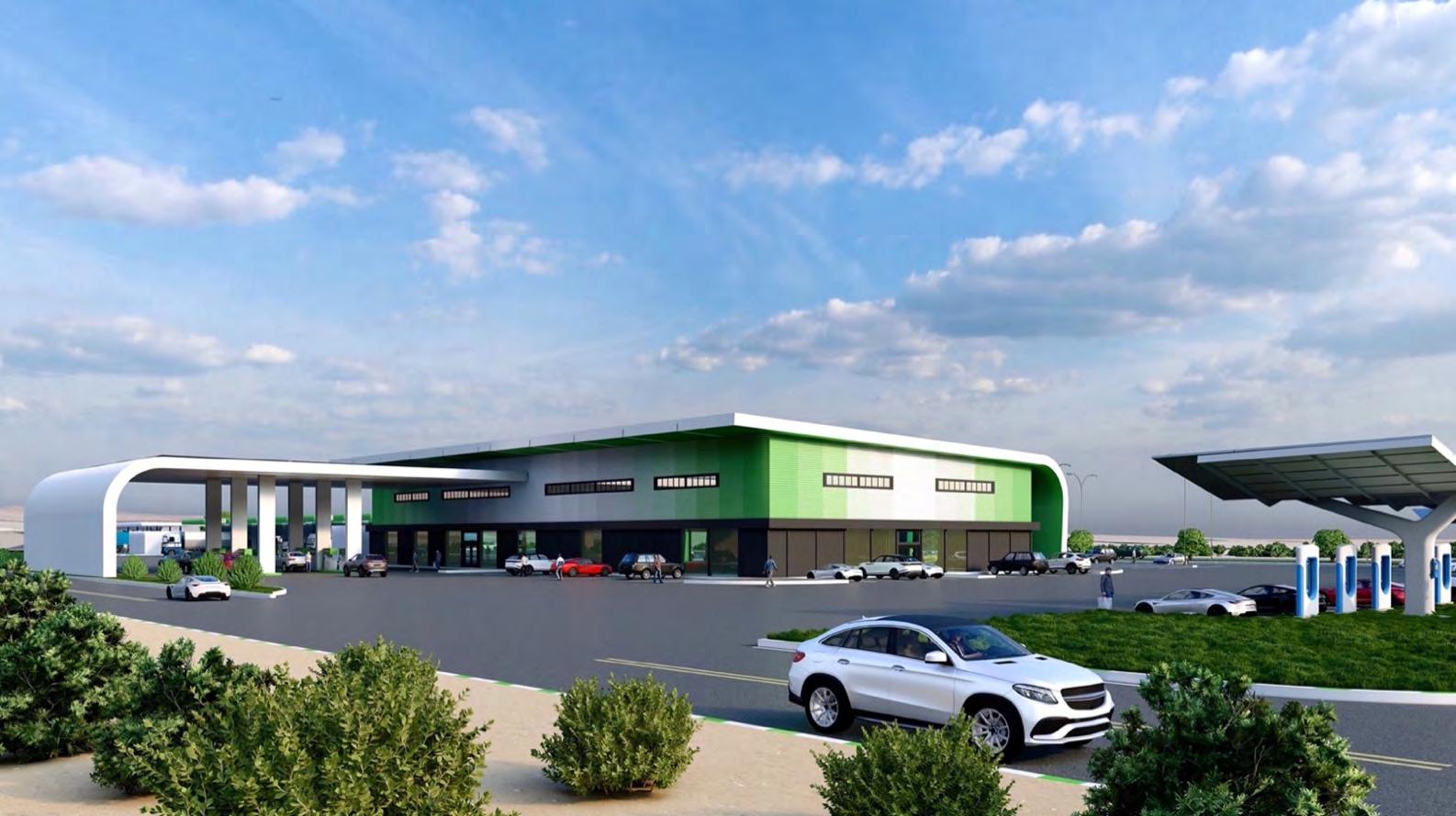
Relax inside while you wait, have a cup of coffee or a bite to eat.




